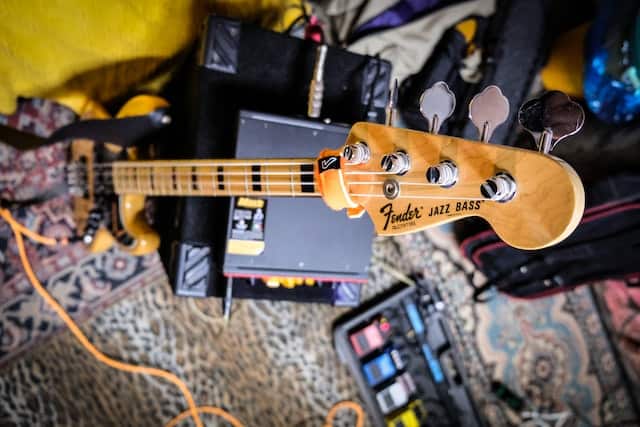The bass guitar is the best of both worlds.
That is to say, a bass guitar provides the rhythm of a drum, with the freedom of an electric guitar.
This instrument is in the middle of the two, creating a kind of bridge that unites both concepts into one solid, powerful idea.
But a bass guitar is more than that. In reality, the more you research this instrument, the more curiosities you’ll find.
For example, it’s a fact that bass guitars have four strings, in comparison with guitars, which have six.
Nonetheless, you might already know that certain bass guitars have five or more strings.
Why is that? What’s the reason behind this?
And most importantly, which are the most relevant differences between a standard 4-string and a 5-string bass guitar?
The main difference is that the 5-string bass has an additional string (B in standard tuning). However, we can point out other factors, like an increase in size, weight, and price when focusing on the 5-string alternative.
There’s more regarding this topic.
Before deciding on which one you’ll take home with you, we recommend checking this article.
1. Range
There’s a big difference regarding range when comparing a 4-string bass and a 5-string bass.
When we talk about range, we’re referring to an extension or decrease in the lower register of notes.
So sure, you can make the bass guitar even lower with a 5-strings instrument!
After all, when a 4-string instrument gets an additional string, this one doesn’t come in the higher register. To be more specific, the 5th string comes before the standard fourth E string, and not after the standard first G string.
Naturally, a 5 string bass counts with a wider lower range. As a result, one will have five extra low notes.
The notes are B, C, Db, D, and Eb in standard tuning.
You can get these with any other normal bass, electric, or acoustic guitar, but of course, you’ll have to change the tuning manually.
2. Sound
If there’s a change in range, then there’s a change in sound.
With a 5-string bass guitar, you get the additional notes we mentioned previously. These B, C, Db, D, and Eb are significantly lower (heavier, denser).
So, we could argue that you can play at “lower sounds” with a five-strings.
What’s great about this implementation is that you can access these five notes without changing your tuning.
As a result, you can create original chords that, with a 4-string, would be impossible to do (although it’s safe to mention, the bass’s main job is not to play chords).
Now, it’s worth noticing again, that you can access all of these five extra notes with a regular 4-string bass. Simply change the tuning and you’re done.
3. Weight
A 4-string bass is lighter than a 5-string bass.
And no. This is not because of the additional string.
However, due to the fact that a five-string bass needs yet one more string, then the instrument requires to have more space.
As a result, manufacturers enlarge the size of the bass, and thus, increase its weight.
The main changes are noticed in the neck, pickups, and bridge. Nonetheless, it’s not too hard to notice the size differentiation between the two at first sight.
So, to sum it up, 5-strings are heavier, and 4-strings are lighter.
4. Price
Once again, it seems that the more strings a bass guitar has, the more the numbers increase.
More notes, more weight, and of course, more money to spend.
Indeed, 5-string bass guitars are more expensive than standard 4-string basses.
Naturally, the real difference in price always relies on the quality of the instrument. But, if you take two bass guitars, the same model, the same brand, but one with four strings, and the other with five, then the latter will cost much more.
The difference between prices is quite broad since some models will have an increase of just a 2-4%, with others having a considerable rise of 11-12%
5. Playability
Needless to say, there is a noticeable difference when playing one, then switching to the other.
Whether one is more comfortable than the other, we cannot tell. That relies solely on the player’s preferences.
Some find certain 5-string bass model strings too close to one another, almost guitar-like. For those who are more used to playing bass than guitar, a 5-string could be more uncomfortable than a 4-string.
This problem only aggravates when musicians have small hands and find problems reaching the entire area of the fretboard.
Once again, this is not always the case and varies according to the musician.
Naturally, it’s worth pointing out that even if the instrument is hard to master in the beginning, steady practice will get rid of the problem.
6. Amp Issues
Unfortunately, certain bass amp models cannot transfer the lowest B note through the speaker.
We are talking especially about older units with 10-inch speaker cabinets.
This makes a 5-string bass a bit useless, but of course, it depends on the amp and your play style.
It’s not that the guitar won’t make any sound, it’s just that some older units weren’t prepared for the pitch of the low B and they might rattle and sound like having a hard time when you play it.
If you stay away from it, probably nothing awful would happen, but that pretty much defeats the purpose of having the extended range.
One way or another, a standard 4-string bass will work anywhere.
Summary
Here you have a quick summary of the main characteristics of the two:
| Feature | 4 String Bass | 5 String Bass |
| Range | Limited (standard tuning) | Considerably wider (standard tuning) |
| Standard Tuning | E, A, D, G | B, E, A, D, G |
| Price | Standard | More expensive (an increase of 5%-12%) |
| Size | Suitable for small hands | Bigger; not appropriate for small hands |
| Weight | 8.0lb – 9.6lb | 8.5lb – 12lb |
| Neck | Thinner | Wider |
| Amp | Works in every amp | Issues on some older amps |
| Playing Difficulty | Slightly Easier | Slightly Harder |
Which is best for a beginner?
First of all, we must point out that both models are perfect for beginners.
Just as with any other instrument, it is always a matter of practicing. Trial and error are pivotal for proper development and ultimate mastery.
With that said, the majority believes that it’s wiser to start with a four-string bass.
Think about it. Some people get into music by playing guitar first.
They get used to six strings, being the sixth one the E standard one.
In a regular 4-string bass, they will find all the guitar strings, with the exception of the first and second (E, B).
However, with a five-string bass, the extra string that comes with it will be neither the first E string nor the second B string. The fifth bass string will be in a different position, which beginner guitarists have never tried.
This might be confusing at first.
In addition, the bigger size of a five-string bass will not be suitable for players with smaller hands. It would probably take them a bit longer to get used to it.
With a 4-string bass, it’s less common to face friction when learning to play the instrument, which is pivotal to avoid excessive frustration.
And let’s not forget, standard bass guitars are lighter and considerably cheaper (this last part is important for beginners who are saving money to buy their first instrument).
Are 5 strings better for certain genres such as metal?
Five-string bass guitars are versatile.
We have already covered that they add five extra low notes in standard tuning.
That is to say, one gets a wide amount of notes without the need of changing to alternative tunings.
As a result, it’s safe mentioning that 5-string bass guitars are great for certain metal genres.
Whether it is better or not, depends not on the music genre, but on the musician itself.
Some players are more comfortable changing the tunings on a regular four-string bass. If a band always plays in drop C# or C standard, there is no need to have a bass in E standard with extra notes.
On the contrary, metal artists whose tuning changes according to the song may find a 5-string more suitable.
All in all, it’s not uncommon to find metal artists (especially in modern metal) whose bass players use a five-string bass.
Which one should you get?
Now, we have covered too many characteristics of these instruments.
Which one should you get? Well, as we always say, it depends!
Generally, a four-string bass is enough. Beginners will find it easier to understand and will help them get used to different tunings.
Bear in mind, that with a 5-string bass, there’s no need to change to tunings such as drop D.
In a sense, this is simpler. However, it’s better to get the hang out of alternative tunings when starting into music to understand an instrument even better.
Also, we cannot look away from the fact that money plays a major role at the time of choosing an instrument.
Four-string bass guitars will always be cheaper than their five-string cousins.
Now, the other side of the coin is that, if you really want a five-string bass, then you should go for it.
Who knows? It could suit your musicians’ goals better than a standard 4-string.
Our advice, then, is to consider both pros and cons before choosing.
Either one or the other, both models will present their unique charm, so there are no real wrong selections here.

Hello there, my name is Ramiro and I’ve been playing guitar for almost 20 years. I’m obsessed with everything gear-related and I thought it might be worth sharing it. From guitars, pedals, amps, and synths to studio gear and production tips, I hope you find what I post here useful, and I’ll try my best to keep it entertaining also.





